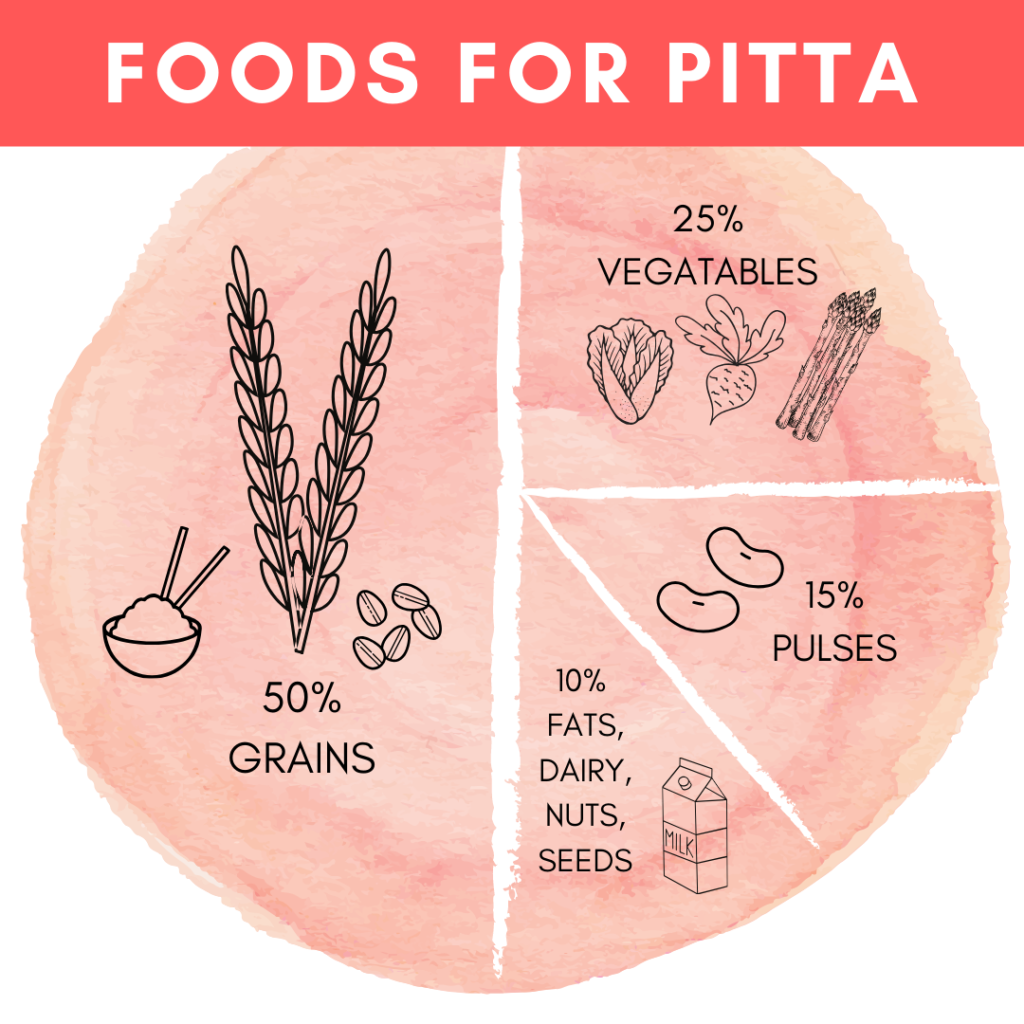If you’re starting on your Ayurveda journey, and you’ve just discovered that your dosha constitution is Pitta – you’re probably looking for food and nutrition advice for the Pitta dosha.
Hopefully this post will outline the basics of what a pitta diet should be, which foods to avoid, and which to eat plenty of! You’ll learn during this post which food pacify Pitta, and which help balance your overall constitution when you’re a pitta dosha type.
A broad overview of the pitta diet
I created the chart below to show you a rough breakdown of what the pitta diet should look like, and the kinds of food pitta doshas should be striving to eat (and in what quantities). Underneath the chart you’ll find more specific information about the specific ingredients that can pacify pitta, and will work extremely well for pitta diets.

50% grains – in more detail
The grains that will work well for a pitta dosha are; amaranth, wholemeal grains, spelt, basmati rice, oats, quinoa, wheat, (and wheat brand) and (in small quantities) corn. These should make up a large part of each meal.
25% vegetables – in more detail
There are many vegetables that will help pacify pitta and work perfectly in a pitta diet. Some of these include; aubergines, green leafy vegetables, cucumber, cauliflower, beetroot, cabbage (all kinds), peas, carrots, parsnips, artichokes, broccolli and potatoes. Seedless tomatoes are also good in small quantities.
15% pules – in more detail
Pittas are lucky because they can eat all pules with no issues. Pules work great for the pitta dosha, just be sure they are well soaked and that you give them plenty of spices and seasoning. Some good ones to try out would be; chickpeas, red lentils, yellow lentils, soy products, mung beans (check out these recipes) and kidney beans.
10% fats / dairy / nuts – in more detail
The smallest group on your plate should be fats, dairy products and nuts. These are still important for your diet though as a pitta, so make sure you get that 10% on your plate. Try ghee for your fats, it’s delicious and versatile. You could also try coconut oil (cooling for the pitta dosha) or olive oil. Dairy products you may want to try are; buttermilk, unsalted butter, mozzarella and soft low-fat cheese.
Remember!
You don’t need to be restricted to the food listed above in your food chart. You’ll want to add plenty of other flavour elements into your food too, such as spices and herbs, salt, sweeteners, fruit and drinks. Some of the recommended items that fall into these categories are listed below:
- Spices and herbs: Basil, curry power, curry leaves, fennel, coriander, cumin, peppermint, mint leaves, rosewater.
- Sweeteners: Maple syrup, raw cane sugar, fresh honey.
- Fruit: Cooling fruit such as red grapes, apples, apricots, blueberries, pears and figs.
- Drinks: Apple juice, Mango juice, fennel tea, mint tea, jasmine tea, almond milk and rice milk.
What foods should a pitta dosha avoid?
As a rough outline (and something visual to save onto your phone or Pinterest board) I’ve created a graphic below. But I’ce dug a little deeper into this underneath, so you can understand a little more which foods you should reduce or avoid when eating a pitta dosha diet.

You can help balance and soothe pitta by avoiding the following foods:
- Rye bread (rye grains)
- Radishes
- Seaweed
- Hot peppers
- cashews
- peanuts
- pistachios
- walnuts
- sesame oil
- parmesan
- sour cream
- toghurt
- orange juice
- mustard seeds
- coffee
- chocolate
- cranberries
- strawberries
- sour cherries
Hopefully that list is helpful to have as a reference! Often when starting eating an Ayurveda diet like this pitta diet, don’t go too drastic all at once. Introduce new foods, and reduce old ones, and gradually you’ll start seeing results (without feeling like the change has been too sudden).




